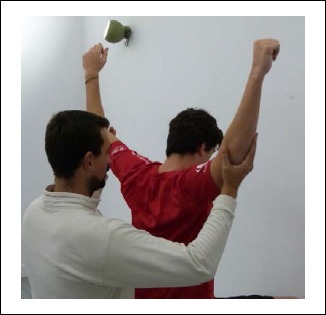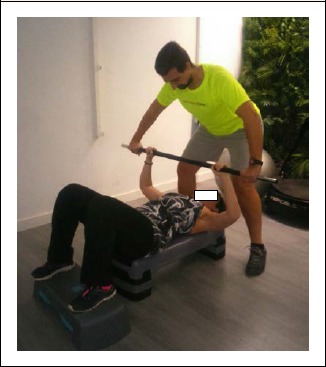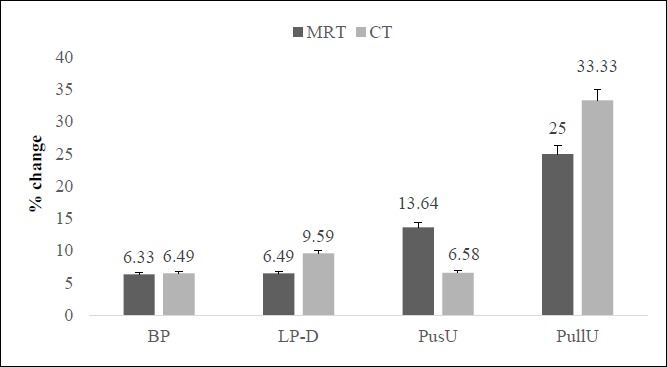Manual Resistance versus Conventional Resistance Training: Impact on Strength and Muscular Endurance in Recreationally Trained Men (original) (raw)
. 2017 Aug 8;16(3):343–349.
Abstract
Manual resistance training (MRT) has been widely used in the field of physical therapy. It has also been used as a strength training method due to the accommodating resistance nature of this modality. The aim of the present study was to compare the effects of an 8-week MRT program on maximum strength and muscular endurance in comparison to conventional resistance training in recreationally trained men. Twenty healthy recreationally trained male subjects were recruited and divided into a MRT training group and a conventional training (CT) group. CT group performed bench press and lat pull-down exercises, and the MRT group performed similar movements with resistance provided by a personal trainer. Both groups completed similar training protocol and training load: 2 training sessions weekly for 3 sets of 8 repetitions at an intensity of 8 to 10 on the perceived exertion scale of 0-10. Initial maximum strength differences were not significant between the groups. Neither group showed significant changes in muscular strength or endurance. Despite the statistically non-significant pre- to post differences, a trend for improvement was observed and effect size (ES) calculations indicated greater magnitude of effects for strength and endurance changes in the MRT group in lat pulldown (g=0.84) compared to CT group. Effectiveness of MRT is similar to CT for improving muscular strength and endurance. MRT can be used as a supplemental or alternative strength training modality for recreationally trained subjects, or be considered by personal trainers especially in low equipped facility conditions.
Key points.
- Resistance training promotes improvement in muscular strength and endurance
- MRT is an effective alternative form of resistance training for recreationally trained men.
- MRT can be effective to improve muscular strength and endurance in recreationally trained men.
- MRT should be considered as alternative form of resistance training by personal trainers and coaches.
Key words: Strength training, bench press, lat pull-down, maximum strength
Introduction
Training to increase muscular strength has been shown to be effective in increasing athletic performance (McGuigan et al., 2012) as well as improving general health (Garber et al., 2011; Pollock, et al., 2000). In fact, recent scientific literature demonstrates that the adaptations obtained through resistance training can include improvements in health related parameters, such as the neuromuscular system (increasing the transversal section of skeletal muscle as well as its contractile capacity), the skeletal system (increasing bone mineral density), the cardiovascular system (assisting in the regulation of lipid profiles as well as improving the cardiovascular system), metabolic profile (improving muscular sensitivity and increasing glucose consumption, as well as increasing insulin response) and psychosocial well-being (Garber et al., 2011; Pollock et al., 2000).
Conventional resistance training (CT) is typically carried out by using external resistance that may come from the use of dumbbells, barbells, inertial resistance or hydraulic resistance (Chulvi-Medrano, 2012). Manual resistance is a type of external resistance which requires a partner or a trainer to provide and control the amount of applied resistance throughout the entire range of movement (Chulvi-Medrano, 2012; Teixeira, 2011; Williams, 2010). This training modality can be of great help to personal trainers, given that it is an economical type of training and allows for versatility and personalization of training loads, especially for professionals who work outside of training facilities (ACSM, 2013; Teixeira, 2013). It has been suggested that a major advantage of the MRT modality over CT is the accommodating nature of the applied resistance as opposed to the constant external resistance seen with the use of weights and machines (Dorgo et al., 2009a). Accommodating resistance approaches (also referred to as semi-isokinetic resistance) aim to control the speed of movement through the full range of motion (Haff and Triplett, 2016). This action, theoretically, combats the changing mechanical advantages of joint movements typically seen in constant external resistance exercises by challenging the involved muscles for maximum force exertion throughout the entire movement. However, research has been sparse and inconclusive on accommodating resistance training, and particularly scarce on the MRT modality.
To date only a few studies have provided analysis of manual resistance training within the literature. Studies have demonstrated that manual resistance training (MRT) is effective in increasing strength and muscular endurance in the general untrained population (Teixeira, 2011; Teixeira, 2013), and in special populations such as those with Duchenne muscular dystrophy (Bohannon and Jones 1986), orthopedic therapy patients (Paine and Voight, 2013), elderly (Tokumaru et al., 2011), untrained adults (Dorgo et al., 2009a) and youth (Dorgo et al., 2009b).
Nonetheless, there are few studies that compare the efficacy of manual resistance training in relation to conventional resistance training, and no existing studies have used recreationally trained subjects for such comparison. For this reason, the present study aimed to compare the effects of manual resistance training and conventional resistance training in trained men on maximum strength and muscular endurance. Our initial hypothesis was that an identical 8-week MRT and CT training program would result in similar training adaptations.
Methods
Approach to the problem
The study was designed as a single training location, longitudinal training intervention, in which recreationally active and resistance-trained males participated in a 2 day/week MRT or CT program for 8 weeks. Muscular strength and muscular endurance were assessed before and immediately after the 8-week intervention, using strength and endurance field tests.
Subjects
Twenty healthy, young, and recreationally trained men with at least 1 year of resistance training experience were recruited for the study. All subjects provided written informed consent, which explained the experimental procedures of the study approved by the Ethics Committee of the University of Alicante. Subjects were also surveyed to determine if they had sufficient experience in performing the target exercises (minimum 1 year of systematic resistance training). A software (AleatorMetod.xls www4.ujaen.es/~mramos/EPIP/AleatorMetod.xls) was used to randomly divide subjects into two groups: manual resistance training (MRT) (n = 10; mean ± SD: age, 23.60 ± 2.06 years; height, 1.84 ± 0.09 m; body mass, 75.20 ± 10.86 kg; Body Mass Index (BMI), 22.47 ± 4.74; strength training experience, 3.05 ± 1.56 years) and conventional resistance training (CT) (n = 10; age, 24.20 ± 1.95 years; height, 1.80 ± 0.05 m; body mass, 76.00 ± 16.40 kg; BMI, 23.25 ± 4.44; strength training experience, 3.30 ± 1.70 years). All subjects were free of any cardiovascular disease or orthopedic problems. Subjects were instructed to continue with their usual resistance training regimen but were asked to exclude any push or pull upper-body exercises. Subjects were further instructed to maintain their normal dietary habits throughout the study and were asked not to use performance enhancing substances or ergogenic aids.
Maximum muscular strength
All tests were carried out at the same time of day (approximately 10:00 AM). All subjects were instructed to abstain from exercise 48 hours prior to the tests, as well as from ingestion of stimulant substances. After a standardized warm up of 5 minutes including light jogging and dynamic stretching exercises for the upper limbs, muscular strength was assessed by the 1 Repetition Maximum (1RM) test for the target exercises. The order of exercise tests was randomized among subjects. Maximal strength was tested for the bench press and lat pull-down exercises according to the procedures described by the National Strength and Conditioning Association (Baechle and Earle, 2007).
After a standard warm-up subjects were asked to complete 5-10 repetitions with a light-to-moderate load. After a 2.5-minute rest period, a load of 70% of the estimated 1RM was utilized to perform three to five repetitions. Subsequently, subjects were asked to complete their first 1RM attempt. The load was gradually increased between attempts and a 2.5-minute rest period was provided between each successful lift. All subjects’ 1RM was successfully measured within five testing attempts. The technical execution of each exercise was standardized using NSCA’s proper technique guide (Baechle and Earle, 2007), and was continually monitored by the researchers to ensure consistency in the testing protocol. For the bench press, after assuming a supine five-point body contact position on a bench, subjects grasped the bar with a pronated grip. The downward movement was considered successful if the bar touched the chest at approximately nipple level. For the upward movement full extension of the elbows was required for a successful lift. For the lat pull-down exercise proper technique began with grasping the bar in a shoulder-width position with a pronated grip. Only a slight backward lean was allowed and subjects were required to pull the bar down toward the upper chest, touching the sternum with the bar before extending the elbows to starting position. 1RM for each exercise was recorded for the heaviest weight subjects were able to lift with correct form for one full repetition. Fifteen minutes of rest was allowed between exercises to allow full recovery. During testing the researchers provided verbal motivation for the subjects.
Muscular endurance
Muscular endurance was assessed for each subject using the pull-up and push-up tests according to the American College of Sports Medicine protocols (ACSM, 2008), recording the maximum number of repetitions performed consecutively without rest. For the push-up exercise, the position was personalized by locating the hands just below the shoulders (biacromial distance). Hand position was determined prior to the push-up attempt with a mark on the floor. A correct repetition was recorded as long as the subject’s chin touched the floor while maintaining the rest of their body in the correct position. For the pull-up exercise, the subjects were instructed to grab the bar with palms pronated at the biacromial distance that was previously recorded. The chin of the subject was required to reach above the bar to be considered a full repetition.
Perceived exertion
The level of perceived exertion was evaluated by applying a pictogram with descriptions of intensity (0 = no effort; 10 = maximum effort), known as OMNI-RES (Robertson et al., 2003). Upon completing each training set, subjects were asked to indicate the level of intensity they were experiencing, referencing the scale. For both groups the goal was to maintain a perceived exertion of 8 during all sets and training sessions, a value equivalent to an exercise with “hard” effort, which has been suggested appropriate for improving muscular fitness (Lagally et al., 2009). This protocol has been used in previous studies (Lagally et al., 2009; Naclerio et al., 2011).
Training protocol
Training for both groups was carried out 2 days per week over the course of 8 weeks, based on the training protocol used in a similar study by Staron et al. (1994) suggesting that such protocol sufficiently elicited skeletal muscle adaptations to observe strength gains in both men and women. Training frequency and program duration recommendations from Tan (1999) were also taken into consideration when designing the intervention protocol.
Each session began with a standardized warm-up identical to the warm-up protocol of the testing sessions. Training for the CT group consisted of the bench press and lat pull-down exercises completing 3 sets of 8 repetitions performed with a controlled intensity of level 8 (“hard”) on the 0-10 perceived exertion scale. A 60-second rest interval was given between sets for passive recovery. Exercise cadence was controlled using a metronome programmed for 2-second concentric and 2-second eccentric phases. The MRT group performed the same movements with the same cadence and the same set/repetition/rest time scheme, but with an experienced and certified personal trainer applying manual resistance (Figures 1 and 2). This protocol was similar to that carried out by Vetter and Dorgo (2009) with highly fit dancers. The perceived exertion for the MRT group also targeted 8 on the 0-10 scale. In both groups, the resistance was adjusted if the level of perceived exertion was below or above 8.
Figure 1.

Lat pull-down exercise with a personal trainer applying manual resistance.
Figure 2.

Bench press exercise with a personal trainer applying manual resistance.
Statistical analyses
Statistical analyses were performed with SPSS statistical package (IBM SPSS Statistics 20). A Shapiro–Wilk test was used to confirm normal distribution and a Mauchley test of sphericity to verify homogeneity of variance. A two-way analysis of variance (ANOVA) on group (MRT and CT) and time (baseline and post) was applied. When a significant F-value was detected, pairwise comparisons were performed using the DMS post-hoc procedure. Statistical significance was set at p < 0.05. Effect size was estimated with Hedges g (Cooper et al., 2009). The following scale was used to categorize the magnitude of effect: < 0.2 = trivial; 0.2-0.5 = small; 0.5-0.8 = medium; 0.8-1.3 = large, and > 1.3 = very large. All variables are reported as mean ± standard Deviation (SD).
Results
Data analysis of pre- and post-test data did not show significant differences for any of the outcome variables (p > 0.05). Table 1 summarizes the changes in strength and muscular endurance performance between the MRT and CT groups. Figure 3 describes percent improvements after the 8-week intervention for each testing variable for the two groups. The magnitude of effect for the MRT group was small for the 1RM bench press (g=0.41) test and the push-up muscular endurance test (g=0.39). The effect size for the lat pull-down strength (g=0.84) was large and for the pull-up muscular endurance was moderate (g=0.59). On the other hand, small effect sizes were observed for the CT group for both strength measures (g=0.28) and the push-up endurance test (g=0.21), while a moderate effect size for the pull-up muscular endurance test (g=0.56) (table 1).
Table 1.
Mean (±standard deviation) values for maximum strength and muscular endurance before and after the 8-weeks training intervention.
| Test | Group | Pre | 95% CI | Post | 95% CI | _P_-value | Effect Size | |
|---|---|---|---|---|---|---|---|---|
| g | Magnitude | |||||||
| BP | MRT | 79.00 (13.49) | 69.34-88.65 | 84.50 (11.65) | 76.16-92.84 | 0.368 | 0.41 | Small |
| 1RM (kg) | CT | 77.50 (1637) | 65.79-89.21 | 82.00 (14.18) | 71.85-92.14 | 0.253 | 0.28 | Small |
| LP-D | MRT | 73.50 (7.83) | 67.89-79.10 | 80.50 (7.97) | 74.79-86.21 | 0.135 | 0.84 | Large |
| 1RM (kg) | CT | 76.50 (13.55) | 66.81-86.19 | 81.00 (11.25) | 72.95-89.05 | 0.334 | 0.34 | Small |
| PusU | MRT | 21.90 (6.04) | 17.57-26.22 | 24.60 (7.16) | 19.47-29.73 | 0.370 | 0.39 | Small |
| (reps) | CT | 21.90 (7.89) | 16.25-27.54 | 23.40 (6.14) | 19.00-27.79 | 0.618 | 0.21 | Small |
| PullU | MRT | 7.60 (3.53) | 5.07-10.13 | 9.60 (2.87) | 7.54-11.66 | 0.165 | 0.59 | Medium |
| (reps) | CT | 6.50 (2.83) | 4.46-8.53 | 8.40 (3.56) | 5.85-10.95 | 0.187 | 0.56 | Medium |
Figure 3.

Percent of improvements after the 8-week intervention for each exercise. MRT = manual resistance training group (n = 10); CT = Conventional strength training group (n = 10); BP = Bench Press; LP-D = Lat pull-down; PusU = Push-up; PullU = Pull-ups.
Discussion
Past studies have shown that MRT is effective in improving muscular strength and endurance in different populations. The effectiveness of MRT in therapeutic populations was noted by Bohannon and Jones (1986), with a single case study carried out on a person affected by Duchenne muscular dystrophy. In their study, MRT was applied to muscle groups in the lower limbs 3 days per week for 12 weeks, obtaining an increased capacity of 32.7% for the left leg and 28.5% for the right leg to generate isometric extension force (Bohannon and Jones, 1986). MRT has also been extrapolated to the elderly population in the study by Tokumaru et al. (2011) where MRT was applied for 24 weeks, with one session per week during the first 12 weeks and two sessions per week in the last 12 weeks. During this period, older adult subjects performed MRT consisting of one set of 10 repetitions of leg extension. Each repetition consisted of a 7-second concentric phase and a 6- to 8-second eccentric phase, with resistance adjusted to accommodate at all times. The results showed an increase in maximum voluntary contraction for leg extension of 13.2% and 29% after 12 and 24 weeks, respectively (Tokumaru et al., 2011). Recently, La Scala Teixeira et al. (2016) has shown MRT is a viable and safe alternative for application in hypertensive men, reducing the need for expensive equipment.
However, there is a lack of information on the effects that MRT can have in younger populations and those with recreational training experience, which is why the aim of the present study was to compare the effects between manual resistance and conventional resistance-training on maximum strength and muscular endurance in young recreationally trained men. The main results of the present study show that there were no significant improvements in either group, neither for maximum strength nor muscular endurance, despite a tendency towards improvement in the MRT group. This is contrary to the results demonstrated by Dorgo et al. (2009b), who observed significant improvements in muscular endurance in a group of 67 high school students. The discrepancy in the results may be attributed primarily to two parameters: first, the age and training status of the selected subjects; while non-trained high school students were selected for Dorgo’s study (2009b), our study involved young adults with several years of strength training experience. Secondly, our study lasted 8 weeks while Dorgo’s intervention was for 18 weeks. In another study led by the same researcher (Dorgo et al., 2009a), it was observed that MRT with a frequency of 3 days per week for 14 weeks, with a range of 8-12 repetitions and a cadence of 3-second eccentric and 3-second concentric movement resulted in significant improvements of 7.37% for the 1RM bench press test. The authors also included a maximum squat strength test, where they observed more pronounced results of 20.55% improvement for the MRT group. Although the MRT group obtained improvements in these tests similar to the conventional training group, there were no significant differences between the groups (Dorgo et al., 2009a).
In the same study, the effects of MRT on muscular endurance were measured (Dorgo et al., 2009a); unlike our study, which evaluated this parameter with the total number of repetitions in calisthenic exercises, these authors opted to record the maximum number of repetitions for the bench press and back squat with a load of 70% 1RM. In this case, authors also observed significant improvements, recording an increase of 43.14% for the bench press, without finding statistical difference from conventional training. Again, the importance of training volume (duration and training frequency) in obtaining improvements in the studied parameters is clear; while our experimental design included 2 sessions per week for 8 weeks, Dorgo’s studies included 3 sessions per week for 14 weeks. It appears that MRT may be effective in trained subjects only through a higher training frequency and longer duration intervention.
In addition, the number of exercises included can be considered a limitation in our study, given that we selected two exercises, while in Dorgo’s studies six to nine exercises were included for the major muscle groups (Dorgo et al., 2009a; 2009b). Finally, a highly influential variable is the experience of the subjects, since observed improvements are more pronounced in subjects with little strength training experience, as in the case of the study of Vetter and Dorgo (2009), in which 10 dance athletes with little or no experience in strength training obtained significant improvements in the 1RM test for bench press and lat pull-down, with increases of 8.5% and 3.3%, respectively. In the current study, the MRT group showed a change of small to moderate ES in all variables, which leads us to believe that the short duration of the intervention did not allow significant differences.
It is important to note that the repetition protocol used in this study was not performed until concentric failure (perceived exertion of 8 on the 0-10 scale). Previously it was suggested that execution until concentric failure is an essential condition for promoting adaptations in trained subjects (Nóbrega and Libardi, 2016), although some disagreements can also be found in the literature (Davies et al., 2016). When using a perceived exertion scale of 0-10, a recent study suggested that rating 8 represents the subject’s ability to complete about two more repetitions to complete failure (Zourdos et al., 2016). It is probable that with trained subjects repetitions to complete failure (perceived rating of 10) are necessary to achieve significant changes in muscular strength and endurance and also that perceived exertion feedback should be solicited from subjects during the completion of a given set. Therefore, our study may have not presented a high enough intensity protocol to elicit strength and endurance adaptations from the trained subjects with a perceived exertion rating of 8.
Resistance training with external variable resistance (e.g. elastic bands and chains) can be beneficial to increase strength when added to conventional external resistance, therefore allows an adaptation to human strength curves (McMaster et al., 2009). This situation can be produced during MRT. It can be argued that if the external resistance is correctly applied, with the appropriate intensity provided by an experienced partner, varying it according to the different mechanics of force production over the trainee’s range of movement, it could have advantages over the conventional resistance training methods (constant external resistance training). In the present study, although the results did not show significant differences between the two modalities, the ES was higher in MRT than CT for all variables except number of repetitions in pull-ups. Thus MRT offers a cost-effective, not location-dependent tool for increasing muscular fitness. These findings have practical implications for fitness professionals such as personal trainers who offer at-home training services. It appears that muscular fitness for both trained and untrained clients may be improved using MRT without the need for expensive fitness equipment.
Comparing the results of the present study with previous studies, we can outline certain limitations to keep in mind. One important limitation of the present study is the duration of the intervention. It is possible that future study protocols need to be longer than 8 weeks, particularly when working with trained subjects. Also, for this population the volume and frequency of training must be higher. Another limitation was the performance of repetitions not to failure, whereas execution until the concentric failure is well recommended for subjects with resistance training experience. Also, a limitation is the dependence of MRT on the experience and strength of the partner (trainer) providing the external resistance. Lacking a partner with appropriate skills and level of strength to properly challenge the trainee, effects of MRT might be minimized, particularly for trained subjects. Nevertheless, the results allow us to conclude that MRT and CT can have statistically similar results when the volume and intensity are similar. Future research is needed to quantify the contribution of the partner (trainer) in the musculoskeletal adaptation providing resistance load, which could be executed with studies applying manually held dynamometers to determine the applied external resistance. Also, related future studies should use longer training interventions (> 8weeks) for trained subjects and monitor the perceived exertion of the subjects for each repetition until complete failure.
Conclusion
In conclusion, neither training modality showed significant changes in the strength and muscular endurance variables, but the ES analysis showed trends for improvement. The ES was higher for MRT than CT for the lat pulldown and similar for the bench press, push-ups and pull-ups, suggesting that MRT can be a viable alternative for personal training in recreationally trained men.
Collectively, these findings provide information for personal trainers or physical therapists, who could apply MRT as an alternative tool to maintain levels of maximum strength and muscular endurance in basic pushing and pulling movements. The results suggest that applying MRT in men with strength training experience may be a viable tool. This information is relevant for personal trainers who give training sessions at locations with a lack of equipment or even based on the characteristics of the target population. Additionally, a previous study (Teixeira, 2013) noted that the acceptance of MRT modality among personal trainer professionals was between “good” and “very good” for 84% of trainers and their clients. Consequently, MRT can be a simple and effective tool to use for recreationally trained clients.
Acknowledgements
The training intervention and data collection procedures represented in the current manuscript comply with the current laws of the country in which they were performed. No funding was received for the current study. No conflict of interest declared for any of the authors.
Biographies

Iván CHULVI-MEDRANO
Employment
Associate professor, Department of General and Specific Didactics, University of Alicante, Alicante, Spain
Degree
PhD; CSCS; NSCA-CPT
Research interests
Resistance training physiology, exercise physiology, clinical exercise
E-mail: ivan.chulvi@ua.es

Tamara RIAL
Employment
Director International Hypopressive & Physical Therapy Institute (Spain)
Degree
PhD
Research interests
Resistance training; women’s health
E-mail: rialtamara@gmail.com

Juan Manuel CORTELL-TORMO
Employment
Full time Professor, Department of General and Specific Didactics. University of Alicante, Spain.
Degree
PhD
Research interests
Strength and conditioning, measurement and evaluation.
E-mail: jm.cortell@ua.es

Yasser ALAKHDAR
Employment
Professor of the Faculty of Physiotherapy University of Valencia, Valencia, Spain.
Degree
PhD
Research interests
Tendons and genetic. ultrasound and muscle changes.
E-mail: yasser@uv.es

Caue V. La Scala Teixeira
Employment
Professor of the Faculty of Physical Education at Praia Grande College, and Coordinator of the Physical Evaluation Laboratory at County of Santos, Brazil.
Degree
MSc
Research interests
Resistance training; functional training
E-mail: contato@caueteixeira.com.br

Laura MASIÁ-TORTOSA
Employment
Benestar Wellness Center
Degree
MSc
Research interests
Resistance training physiology, exercise physiology
E-mail: lauramasiatortosa@gmail.com

Sandor DORGO
Employment
Department of Kinesiology. University of Texas at El Paso
Degree
PhD, CSCS, D*
Research interests
Resistance training, strength and conditioning, aging and exercise
E-mail: sdorgo@utep.edu
References
- American College of Sports Medicine (2008) Health-Related Physical Fitness Assessment Manual. 2nd edition Baltimore: Lippincott Williams & Wilkins. [Google Scholar]
- American College of Sports Medicine (2013) ACSM’s resources for the personal trainer. 4th edition. Baltimore: Lippincott Williams & Wilkins. [Google Scholar]
- Baechle T.R., Earle R.W. (2007) Essential of strength training and conditioning. 2nd edition. Champaign, IL: Human Kinetics. [Google Scholar]
- Bohannon R.W., Jones P.L. (1986) Results of manual resistance exercise on a manifesting carrier of Duchenne Muscular Dystrophy: A case report. Physical Therapy 66, 973-975. [DOI] [PubMed] [Google Scholar]
- Chulvi-Medrano I. (2012) Biomechanic basis of devices for resistance training. A review. Scientia 16, 26-39. [Google Scholar]
- Cooper H., Hedges L., Valentine J. (2009). The handbook of research synthesis and meta-analysis. New York: Russell Sage Foundation. [Google Scholar]
- Davies T., Orr R., Halaki M., Hackett D. (2016) Effect of training leading to repetition failure on muscular strength. A systematic review and meta-analysis. Sports Medicine 46, 487-502. [DOI] [PubMed] [Google Scholar]
- Dorgo S., King G.A., Rice C.A., (2009a) The Effects of Manual Resistance Training on Improving Muscular Strength and Endurance. Journal of Strength and Conditioning Research 23, 293-303. [DOI] [PubMed] [Google Scholar]
- Dorgo S., King G.A., Candelaria N., Bader J.O., Brickey G.D., Adams C.E. (2009b) Effects of Manual Resistance Training on Fitness in Adolescents. Journal of Strength and Conditioning Research 23, 2287-2294. [DOI] [PMC free article] [PubMed] [Google Scholar]
- Garber C.E., Blissmer B., Deschenes M., Franklin B.A., Lamonte M.J., Lee I.M., Nieman D.C., Swain D.P. (2011) Quantity and quality of exercise for developing and maintaining cardiorespiratory, musculoskeletal, and neuromotor fitness in apparently healthy adults: guidance for prescribing exercise. Medicine and Science in Sports and Exercise 43, 1334-1359. [DOI] [PubMed] [Google Scholar]
- Haff G.G., Triplett T. (2016) Essentials of Strength Training and Conditioning. Champaign, IL: Human Kinetics. [Google Scholar]
- Lagally K.M., Amorose A.J., Rock B. (2009) Selection of resistance exercise intensity using rating of perceived exertion from the OMNI-Res. Perceptual and Motor Skills, 108, 573-86. [DOI] [PubMed] [Google Scholar]
- La Scala Teixeira C.V., Ferreira S.E., Azevedo P.H., Chulvi-Medrano I., Dorgo S., DE Salles B.F., Simao R., Gomes R.J. (2016) Effects of manual resistance training and free weight resistance training on post-exercise blood pressure in hypertensive men: a pilot study. The Journal of Sports Medicine and Physical Fitness, Epub ahead of print. [DOI] [PubMed] [Google Scholar]
- Lins-Filho Ode L., Robertson R.J., Farah B.Q., Rodrigues S.L., Cyrino E.S., Ritti-Dias R.M. (2012). Effects of exercise intensity on rating of perceived exertion during a multiple-set resistance exercise session. Journal of Strength and Conditioning Research, 26, 466-472. [DOI] [PubMed] [Google Scholar]
- McGuigan M.R., Wright G.A., Fleck S.J. (2012) Strength training for athletes: does it really help sports performance? International Journal of Sports Physiology and Performance 7, 2-5. [DOI] [PubMed] [Google Scholar]
- McMaster D.T., Cronin J., McGuigan M., (2009) Forms of variable resistance training. Strength and Conditioning Journal 31, 50-64. [Google Scholar]
- Naclerio F, Rodriguez-Romo G, Barriopededro-Moro MI, Jiménez A, Alvar BA, Triplett NT. (2011). Control of resistance training intensity by the OMNI perceived exertion scale. Journal of Strength and Conditioning Research, 25, 1879-1888. [DOI] [PubMed] [Google Scholar]
- Nóbrega S.R., Libardi C.A. (2016). Is resistance training to muscular failure necessary? Frontiers in Physiology 7, 10. [DOI] [PMC free article] [PubMed] [Google Scholar]
- Paine R., Voight M.L. (2013). The role of the scapula. International Journal of Sports Physical Therapy 8, 617-629. [PMC free article] [PubMed] [Google Scholar]
- Pollock M.L., Franklin B.A., Balady G.J., Chaitman B.L., Fleg J.L., Fletcher B., Limacher M., Pina I.L., Stein R.A., Williams M., Bazzarre T., (2000) Resistance exercise in individuals with and without cardiovascular disease: Benefits, rationale, safety, and prescription an advisory from the committee on exercise, rehabilitation, and prevention, council on clinical cardiology, American Heart Association. Circulation 101, 828-833. [DOI] [PubMed] [Google Scholar]
- Robertson R.J., Goss F.L., Rutkowski J., Lenz B., Dixon C., Timmer J., Frazee K., Dube J., Andreacci J., (2003) Concurrent Validation of the OMNI Perceived exertion scale for resistance exercise. Medicine and Science in Sports and Exercise 35, 333-341. [DOI] [PubMed] [Google Scholar]
- Staron R.S., Karapondo D.L., Kraemer W.J., Fry A.C., Gordon S.E., Falkel J.E., Hagerman F.C., Hikida R.S. (1994) Skeletal muscle adaptations during early phase of heavy-resistance training in men and women. Journal of Applied Physiology 76, 1247-1255. [DOI] [PubMed] [Google Scholar]
- Tan B. (1999) Manipulating resistance training program variables to optimize maximum strength in men: A review. Journal of Strength and Conditioning Research 13, 289-304. [Google Scholar]
- Teixeira C.V.L.S. (2011) Manual resistance training: strength training without equipment. São Paulo: Phorte. [Google Scholar]
- Teixeira C.V.L.S. (2013) Manual resistance training: application and acceptance in personal training. Brazilian Journal of Exercise Physiology 12, 98-102. (In Portuguese). [Google Scholar]
- Tokumaru K., Taniguchi C., Morikawa S., Yamasaki Y., Shimada T (2011). The effects of manual resistance on improving muscle strength of the lower extremities of the community dwelling elderly. A clinical intervention study with a control group. Journal of Physical Therapy Science 23, 237-242. [Google Scholar]
- Vetter R.E., Dorgo S. (2009) Effects of Partner’s Improvisational Resistance Training on Dancers’ Muscular Strength. Journal of Strength and Conditioning Research 23, 718-728. [DOI] [PubMed] [Google Scholar]
- Williams C. (2010) Manual resistance training. NSCA’s Performance Training Journal 11, 10-11. [Google Scholar]
- Zourdos M.C., Klemp A., Dolan C., Quiles J.M., Schau K.A., Jo E., Helms E., Esgro B., Duncan S., Garcia Merino S., Blanco R. (2016) Novel resistance training-specific rating of perceived scale measuring repetition in reserve Journal of Strength and Conditioning Research 30, 267-275. [DOI] [PubMed] [Google Scholar]